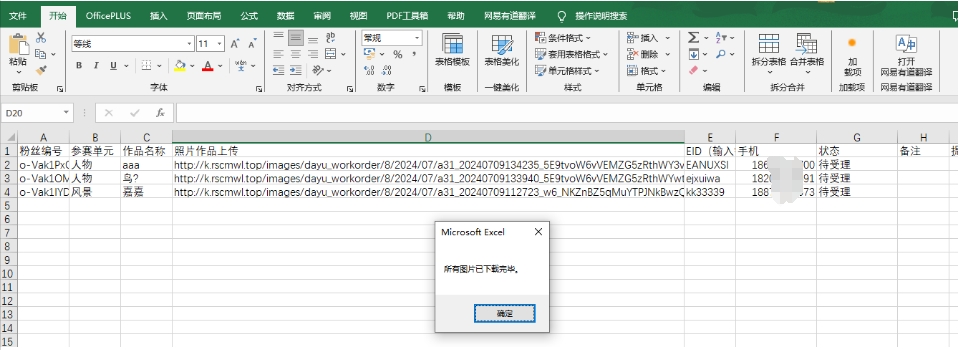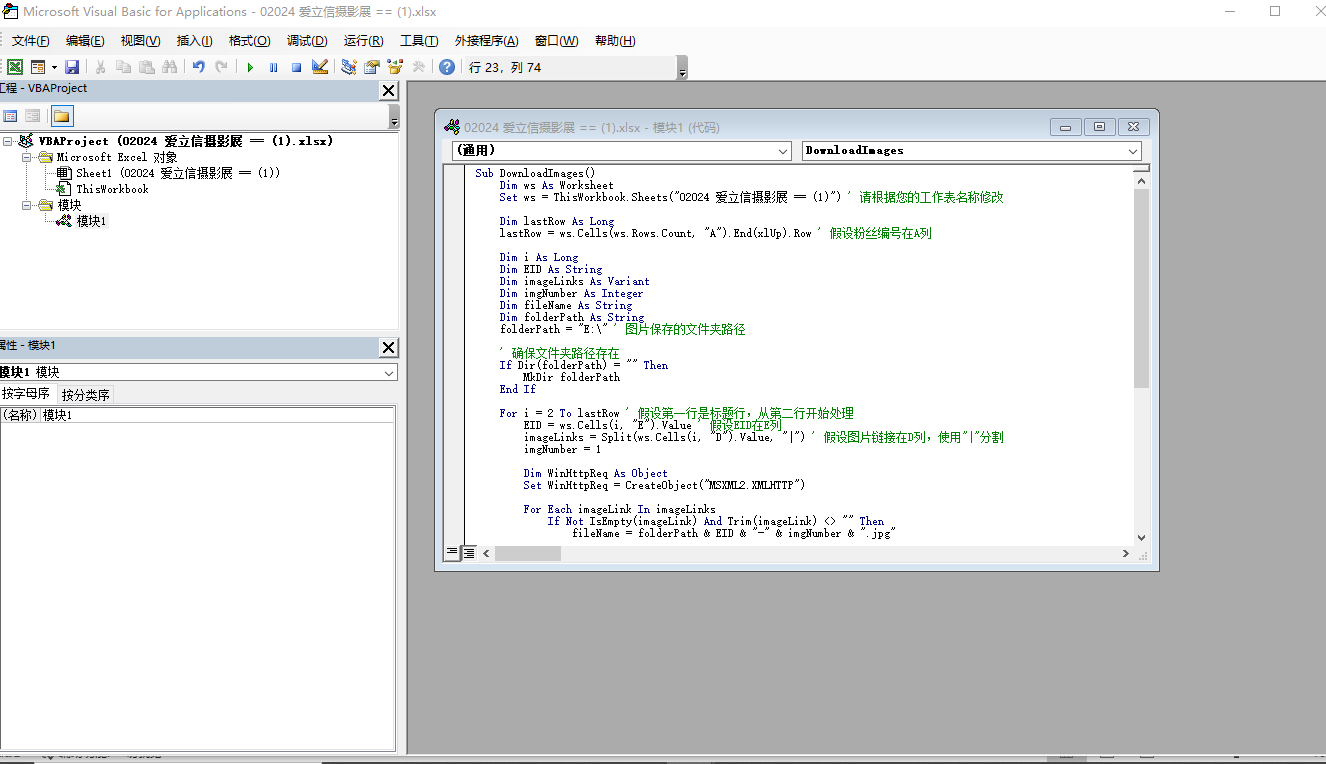2024-07-11
提取图片链接:首先,在Excel中使用公式或手动操作提取每条记录的图片链接。
使用VBA宏下载图片:您可以编写一个VBA宏来实现下载图片的功能。VBA宏可以访问网络,下载图片,并将其保存到本地磁盘。
重命名图片:在VBA宏中,您可以根据EID和图片序号来重命名图片。
Sub DownloadImages()
Dim ws As Worksheet
Set ws = ThisWorkbook.Sheets("02024 爱立信摄影展_k0SjaQ ==") ' 请根据您的工作表名称(不是表格名字)修改
Dim lastRow As Long
lastRow = ws.Cells(ws.Rows.Count, "A").End(xlUp).Row ' 假设粉丝编号在A列
Dim i As Long
Dim EID As String
Dim imageLinks As Variant
Dim imgNumber As Integer
Dim fileName As String
Dim workName As String ' 新增变量以存储作品名称
Dim folderPath As String
folderPath = "E:\2024爱立信摄影展" ' 请根据需要修改保存路径
' 确保文件夹存在
If Dir(folderPath, vbDirectory) = "" Then MkDir folderPath
Dim WinHttpRequest As Object
Set WinHttpRequest = CreateObject("WinHttp.WinHttpRequest.5.1")
For i = 2 To lastRow
EID = Trim(ws.Cells(i, "G").Value) ' 假设EID在G列
imageLinks = Split(ws.Cells(i, "E").Value, "|") ' 假设图片链接在E列,使用"|"分割
' 提取作品名称,新变量workName
workName = Trim(ws.Cells(i, "D").Value) ' 假设作品名称在D列
' 去除作品名称中的不允许字符
workName = CleanFileName(workName)
For imgNumber = 1 To UBound(imageLinks) + 1
' 根据EID和作品名称,设置文件名
fileName = folderPath & "\" & EID & "-" & workName & "-" & imgNumber & ".jpg"
' 使用WinHttpRequest对象下载图片
With WinHttpRequest
.Open "GET", imageLinks(imgNumber - 1), False
.SetTimeouts 5000, 5000, 5000, 5000
.Send
If .Status = 200 Then
Dim fileContent() As Byte
fileContent = .ResponseBody
' 尝试获取Content-Type头信息
Dim contentType As String
contentType = LCase(.GetResponseHeader("Content-Type"))
' 根据Content-Type设置文件扩展名
If InStr(1, contentType, "image/jpeg") > 0 Or _
InStr(1, contentType, "image/jpg") > 0 Then
fileName = Replace(fileName, ".jpg", ".jpg")
ElseIf InStr(1, contentType, "image/png") > 0 Then
fileName = Replace(fileName, ".jpg", ".png")
ElseIf InStr(1, contentType, "image/gif") > 0 Then
fileName = Replace(fileName, ".jpg", ".gif")
Else
MsgBox "未知的图片格式: " & contentType
End If
' 写入文件
Dim fileNum As Integer
fileNum = FreeFile
Open fileName For Binary Access Write As #fileNum
Put #fileNum, , fileContent
Close #fileNum
Else
MsgBox "下载失败,状态码:" & .Status & ",URL:" & imageLinks(imgNumber - 1)
End If
End With
Next imgNumber
Next i
MsgBox "所有图片已下载完毕。"
End Sub
Function CleanFileName(fileName As String) As String
' 替换文件名中的非法字符
Dim illegalChars As Variant
illegalChars = Array("\", "/", ":", "*", "?", """", "<", ">", "|", " ", "?")
Dim newName As String
newName = fileName
Dim i As Integer
For i = LBound(illegalChars) To UBound(illegalChars)
newName = Replace(newName, illegalChars(i), "_") ' 使用下划线替代非法字符
Next i
CleanFileName = newName
End Function
1、在 CleanFileName 函数中新增了字符空格和“•”到 illegalChars 数组中。
使得任何包含非法字符的文件名将被正常处理,替换为下划线。你可以根据需要继续添加或修改非法字符列表。
2确保 fileName 在构建时不会遗漏路径分隔符 \。
Sub DownloadImages()
Dim ws As Worksheet
Set ws = ThisWorkbook.Sheets("02024 爱立信摄影展 == (1)") ' 请根据您的工作表名称修改
Dim lastRow As Long
lastRow = ws.Cells(ws.Rows.Count, "A").End(xlUp).Row ' 假设粉丝编号在A列
Dim i As Long
Dim EID As String
Dim imageLinks As Variant
Dim imgNumber As Integer
Dim fileName As String
Dim folderPath As String
folderPath = "E:\"
If Dir(folderPath, vbDirectory) = "" Then MkDir folderPath
Dim WinHttpRequest As Object
Set WinHttpRequest = CreateObject("WinHttp.WinHttpRequest.5.1")
For i = 2 To lastRow
EID = Trim(ws.Cells(i, "E").Value) ' 假设EID在E列
imageLinks = Split(ws.Cells(i, "D").Value, "|") ' 假设图片链接在D列,使用"|"分割
For imgNumber = 1 To UBound(imageLinks) + 1
fileName = folderPath & EID & "-" & imgNumber & ".jpg" ' 默认使用.jpg格式
' 使用WinHttpRequest对象下载图片
With WinHttpRequest
.Open "GET", imageLinks(imgNumber - 1), False
.SetTimeouts 5000, 5000, 5000, 5000
.Send
If .Status = 200 Then
Dim fileContent() As Byte
fileContent = .ResponseBody
' 尝试获取Content-Type头信息
Dim contentType As String
contentType = LCase(.GetResponseHeader("Content-Type"))
' 根据Content-Type设置文件扩展名
If InStr(1, contentType, "image/jpeg") > 0 Or _
InStr(1, contentType, "image/jpg") > 0 Then
fileName = Replace(fileName, ".jpg", ".jpg")
ElseIf InStr(1, contentType, "image/png") > 0 Then
fileName = Replace(fileName, ".jpg", ".png")
ElseIf InStr(1, contentType, "image/gif") > 0 Then
fileName = Replace(fileName, ".jpg", ".gif")
Else
MsgBox "未知的图片格式: " & contentType
End If
' 写入文件
Dim fileNum As Integer
fileNum = FreeFile
Open fileName For Binary Access Write As #fileNum
Put #fileNum, , fileContent
Close #fileNum
Else
MsgBox "下载失败,状态码:" & .Status & ",URL:" & imageLinks(imgNumber - 1)
End If
End With
Next imgNumber
Next i
MsgBox "所有图片已下载完毕。"
End Sub
在 CleanFileName 函数中新增了字符空格、中文字符“我”、中文字符“额”和“•”到 illegalChars 数组中。
确保 fileName 在构建时不会遗漏路径分隔符 \。
在Excel中,按下 Alt + F11 打开VBA编辑器。
插入一个新模块(在菜单中选择 Insert > Module)。
将上述代码复制并粘贴到新模块中。
修改代码中的工作表名称、列号和文件夹路径以匹配您的Excel文件。
运行宏(可以按 F5 键或在VBA编辑器中选择 Run > Run Sub/UserForm)。
确保工作表名称、列号和文件夹路径与您的Excel文件相匹配。
这段代码使用了 MSXML2.XMLHTTP 对象来发送HTTP请求,这是较新版本的XMLHTTP对象,如果您的Excel版本不支持,您可能需要改回使用 Microsoft.XMLHTTP。
使用更现代的XMLHTTP库:使用 WinHttp.WinHttpRequest.5.1 来代替 MSXML2.XMLHTTP,这可能提供更好的兼容性和性能。
异常处理:添加错误处理来捕获和处理下载过程中可能出现的异常。
HTTP请求超时:为HTTP请求添加超时设置,避免长时间等待响应。
确保路径存在:在保存文件之前检查文件夹路径是否存在。
代码中添加了检查,以确保不会尝试下载空链接,并且不会重复下载已存在的文件。
代码中添加了创建文件夹的逻辑,如果目标文件夹不存在,会自动创建。


